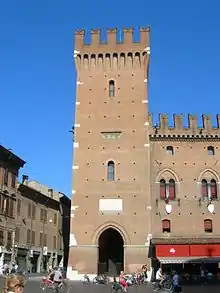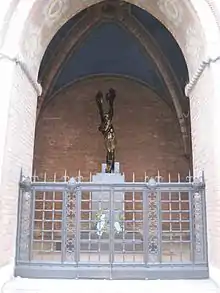Torre della Vittoria
The Torre della Vittoria is a historical building in Ferrara that complements the Palazzo Municipale and at the same time stands apart from it in terms of its size, its reconstruction centuries after the fall of the tower previously located in the same position, and the celebrations that explicitly referred to it in Fascist-era films. It is located on the corner of Piazza Trento e Trieste and Via Cortevecchia, at the beginning of Corso Martiri della Libertà.
 Torre della Vittoria | |
| Location | Ferrara, Italy |
|---|---|
| Coordinates | 44.835696°N 11.618986°E |
| History | |
| Founded | 1924-1928 |
| Periods | High Middle Ages |
| Site notes | |
| Condition | Restored |
History

As part of the action aimed at recovering and enhancing the city's building heritage, begun in the early 1920s, in Ferrara, which began with the restoration of two public buildings that are emblems of the city, namely the Castello Estense and the Palazzo Municipale, radical work was carried out on the latter's façade, the one facing the Duomo. In particular, a new Tower of Victory was erected to replace the original one, designed by Rigobello, which had collapsed during the seventeenth century, in 1570, at the beginning of the seismic swarm that struck the city until 1574.[1]
The will of the municipal administration was, at that time, to recover the ancient appearance of the Municipal Palace to recall the glory of the Este period and, in addition, to celebrate Victory in the First World War with a commemorative monument. This was identified in the gilded bronze statue La Vittoria del Piave by Arrigo Minerbi, which was placed at the base of the tower, a copy based on the 1917—1918 model.[2] The decoration of the entrance to the tower was entrusted in 1927 to Giulio Medini, who was also the author of the renovation of the exterior decorations of the Palazzo Municipale.[3]
The inauguration of the Tower
.jpg.webp)
The inauguration of the Tower was an important celebratory moment for Fascism in Ferrara, in November 1928, and for the occasion, in addition to Italo Balbo, Renzo Ravenna and the main civil, military and religious personalities, the king, Vittorio Emanuele III, also took part.
Architectural Aspects
Built on a 14th-century model, in Gothic style and with materials reminiscent of the Este Castle, it is 57 m high and the top is crenellated, like the reconstructed façade of the Town Hall.
See also
Notes
- In the public subscription for the construction of the tower promoted by the Corriere Padano, Italo Balbo and Renzo Ravenna appear, who donated 500 and 200 lire respectively. Over 4,000 donations were counted, and many of these were from members of the local Jewish community. I. Pavan, Il podestà ebreo, p.44
- Arrigo MInerbi, Pensieri confessioni ricordi, Miilano, Casa editrice Ceschina, 1953
- Giulio, definitively alone in, Lucio Scardino, Bottega Medini — La decorazione murale nel Ferrarese dall’età umbertina a metà Novecento, Ferrara, Liberty house, 2004, pp. 97-102
Sources
Italian sources
- Ilaria Pavan (2006). Il podestà ebreo. La storia di Renzo Ravenna tra fascismo e leggi razziali. Roma-Bari: Laterza.
- Gerolamo Melchiorri (2009). Nomenclatura ed etimologia delle piazze e strade di Ferrara e Ampliamenti, a cura di Carlo Bassi. Ferrara: 2G.
- Archivio storico del Comune di Ferrara - Ufficio Ricerche Storiche
External links
![]() Media related to Torre della Vittoria (Ferrara) at Wikimedia Commons
Media related to Torre della Vittoria (Ferrara) at Wikimedia Commons